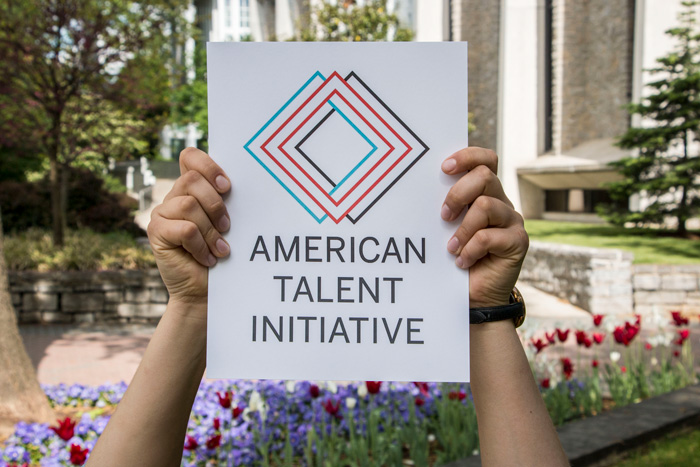Expanding Access and Opportunity

Dickinson joins the American Talent Initiative
Dickinson has joined 67 of the nation’s most respected colleges and universities in an alliance to expand substantially the number of talented low- and moderate-income students at America’s undergraduate institutions with the highest graduation rates. The American Talent Initiative (ATI), supported by Bloomberg Philanthropies, brings together a diverse set of public and private institutions united in this common goal. ATI members will enhance their own efforts to recruit, enroll and support lower-income students, learn from each other and contribute to research that will help other colleges and universities expand opportunity.
“Dickinson is proud to join the ATI, a collaboration that aligns with our mission to attract high-achieving students from diverse socioeconomic backgrounds,” said Dickinson interim President Neil Weissman, adding, “Dickinson is committed to enrolling the most diverse and academically talented class we can afford. We have made great strides in that area and seek to do more.”
Dickinson’s class of 2020 is the most diverse in the college’s 234-year history, including 21 percent domestic students of color, 12 percent international students and 10 percent first-generation college students. Dickinson nurtures positive relationships with community-based organizations such as New Jersey Seeds, Philadelphia Futures, Noble Network and Colleges Horizons to further its outreach efforts to diverse populations of students. Additionally, Discover Diversity at Dickinson—now in its fifth year—brings underrepresented students to campus in November to experience Dickinson during an overnight stay and a traditional open house. The program has resulted in great increases in qualified underrepresented students in the Early Decision application round, which has had a positive impact on the overall applicant pool.
Launched in December 2016, the ATI was founded with a national goal of educating 50,000 additional high achieving, lower-income students at the 270 colleges and universities with the highest graduation rates by 2025. Based on the most recent federal data available, there are approximately 430,000 lower-income students enrolled at these 270 institutions. ATI’s goal is to increase and sustain the total number of lower-income students attending these top-performing colleges to about 480,000 by 2025. To reach this ambitious goal, ATI aims to add more top-performing colleges to its membership in the coming months and years.
Dickinson recognizes that America’s top-performing colleges have an important role to play in this effort. Research shows that when high-achieving, lower-income students attend these institutions, they graduate at higher rates and access to those institutions provides them with a much greater chance of attaining leadership positions and opportunities throughout their lives. Yet in each graduating high school class, there are at least 12,500 lower-income young people with outstanding academic credentials who do not enroll at institutions where they have the greatest likelihood of graduating.
These students have earned the opportunity these schools offer, but for a variety of reasons—including a lack of information about their options, confusion about costs and inadequate financial aid offers—many of them simply lack access. ATI seeks to ensure these “missing” students have a path to attend and thrive at the institutions with the highest-graduation rates and best track records for post-graduate success.
Colleges and universities participating in the ATI will further the national goal of developing more talent from every American neighborhood by:
- recruiting students from diverse socioeconomic backgrounds through robust outreach
- ensuring that admitted lower-income students enroll and are retained through practices that have been shown to be effective
- prioritizing need-based financial aid
- and minimizing or eliminating gaps in progression and graduation rates between and among students from low-, moderate- and high-income families.
Dickinson and other ATI members will share lessons learned as well as institutional data, and throughout the coming years, will annually publish their aggregate progress toward meeting the national goal of 50,000 additional lower-income students by 2025. The Aspen Institute’s College Excellence Program and Ithaka S+R, the two nonprofit organizations coordinating the initiative, will study the practices that lead to measurable progress and share that knowledge through regular publications. The first of these publications focusing on financial strategies to bolster lower-income student success was published in February on the ATI website.
ATI member institutions are committing substantial resources to attract, enroll and graduate students at their individual campuses. This initiative is co-managed by the Aspen Institute’s College Excellence Program and Ithaka S+R and funded with an initial $1.7 million, multiyear grant from Bloomberg Philanthropies. Grant funding will be used for best-practice research and dissemination, convenings of college presidents and staff, and data analysis and reporting.
Learn More
Published April 26, 2017